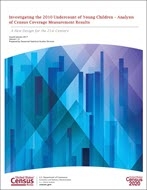
An official website of the United States government
Here’s how you know
Official websites use .gov
A .gov website belongs to an official government organization in the United States.
Secure .gov websites use HTTPS
A lock (
) or https:// means you’ve safely connected to the .gov website. Share sensitive information only on official, secure websites.
-
//
- Census.gov /
- Planning the Count /
- 2020 Census Final Analysis Reports /
- 2010 Undercount of Young Children – Analysis of Coverage Measurement
Investigating the 2010 Undercount of Young Children – Analysis of Census Coverage Measurement Results
Investigating the 2010 Undercount of Young Children – Analysis of Census Coverage Measurement Results
Introduction
The Census Bureau acknowledges the long-standing undercount of young children in decennial censuses and in Census Bureau surveys. Demographers have documented the high undercount of children under the age of 5 (e.g., West and Robinson 1999). Evaluations show that Census Bureau surveys like the American Community Survey (ACS), the Current Population Survey, and the Survey of Income and Program Participation also undercount young children, which can result in biased survey estimates (O’Hare and Jensen 2014). O’Hare (2015) found many other countries have a high net undercount of young children in their censuses.
In this report, we define “young children” as children age 0 to 4. After the 2010 Census, Demographic Analysis estimated a net undercount of about 4.6 percent for young children (Hogan et al. 2013). This translated into a net undercount of almost 1 million young children. O’Hare (2015) shows that the net undercount rates for young children increased from 1.4 percent in 1980 to 4.6 percent in 2010, while the net undercount rate for the adult population (age 18+) went from an undercount of 1.4 percent in 1980 to an overcount of 0.7 percent in 2010. The rise in the undercount of young children underscores the importance of examining this coverage problem in greater detail.
In 2014, the Census Bureau released a task force report summarizing this issue and recommending research to better understand the possible causes for this undercount (U.S. Census Bureau 2014). An interdivisional team is working on several projects to review existing data sources that might provide insights into the high undercount of young children in the 2010 Census.
The 2010 Census Coverage Measurement (CCM) program used dual system estimation to produce population estimates and to estimate coverage of the household population. The CCM program measured overcounts and undercounts across the population. A comparison of the CCM estimates to the 2010 Census showed a small undercount of children under age 5 of 0.72 percent (Mule 2012). However, there are limitations with the CCM program as a method for estimating the coverage of young children. The CCM survey occurred several months after the Census, and the CCM may also miss the same people that the 2010 Census missed (correlation bias). Despite these limitations, the CCM has the benefit of providing microdata to study situations where the census may have erroneously excluded young children.
This report examines the characteristics of young children who were enumerated in the 2010 CCM survey but did not match to a 2010 Census record. These nonmatches could represent young children that the 2010 Census excluded in error. The results provide a preliminary profile of the types of children who are most at risk of undercoverage.
Share
Some content on this site is available in several different electronic formats. Some of the files may require a plug-in or additional software to view.
 Yes
Yes
 No
NoComments or suggestions?


Top

